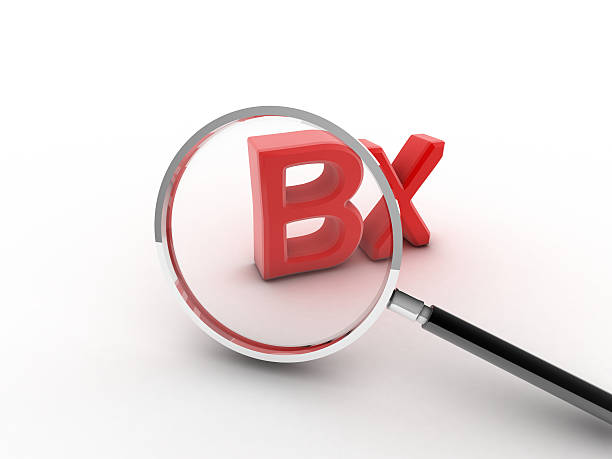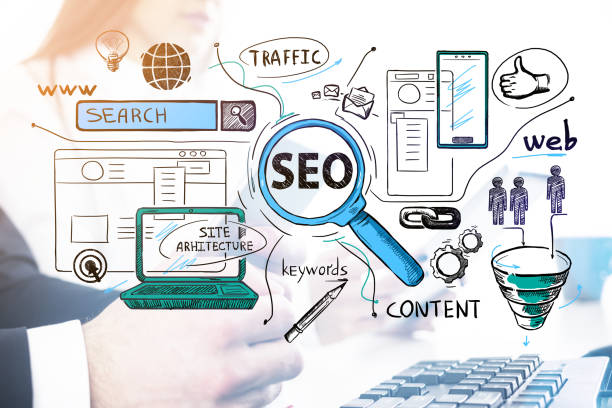What is On-Page SEO and Why Does It Matter?

On-page SEO refers to the set of actions taken within a website to improve the site’s ranking in search engines like Google.
These actions include optimizing content, site structure, code, and other internal factors.
The importance of on-page SEO lies in the fact that search engines, by examining these factors, determine whether a website is useful and relevant to users or not.
An optimized site has a better chance of appearing in top search results, and as a result, attracts more traffic.
In fact, on-page SEO is the foundation for the success of any SEO strategy.
Without strong on-page SEO, other efforts in off-page SEO and content marketing may be ineffective.
On-page SEO helps make your website more understandable to search engines.
This includes using relevant keywords, creating high-quality content, and properly structuring pages.
By optimizing these factors, search engines can easily review and index your site’s content.
This leads to increased site ranking in search results and more traffic.
The importance of internal website optimization is so great that ignoring it can negate your efforts in other areas.
For example, if a website has great content but a poor structure or does not use keywords correctly, it may not rank well in search results.
Therefore, on-page SEO should be considered the first and most important step in any SEO strategy.
Losing potential customers due to an unprofessional website? Rasaweb is your answer! With our specialized corporate website design services:
✅ Enhance the credibility and standing of your business
✅ Experience attracting more targeted customers
⚡ Act now to receive a free consultation!
Keyword Research – The Beating Heart of On-Page SEO

Keyword research is the process of identifying and analyzing the words and phrases that users use to search for information in search engines.
These keywords should be relevant to your website’s content and strategically used on various pages of the site.
Effective keyword research helps you understand exactly what users are looking for and adjust your content based on their needs.
There are various tools for keyword research, including Google Keyword Planner, Ahrefs, and SEMrush.
Using these tools, you can check relevant keywords, their search volume, and the level of competition.
Choosing the right keywords has a significant impact on the success of on-page SEO.
Keywords should be both relevant to your business and have a decent search volume.
You should also pay attention to the level of competition for keywords.
Choosing high-competition keywords may be difficult, but if you can rank well for these keywords, a lot of traffic will be attracted to your site.
On the other hand, choosing low-competition keywords may be easier, but will attract less traffic to your site.
After identifying keywords, you should use them strategically on different pages of your website.
This includes using keywords in page titles, meta descriptions, the main text of pages, and image Alt tags.
However, you should be careful to use keywords naturally and without exaggeration.
Excessive use of keywords can lead to your site being penalized by search engines.
A smart on-page SEO strategy creates a good balance between keyword usage and providing high-quality and useful content for users.
Content Optimization – Creating Valuable and Engaging Content

Content optimization means creating content that is both useful and engaging for users and understandable and relevant for search engines.
This includes writing high-quality articles, creating attractive images and videos, and providing accurate and up-to-date information.
Optimized content should answer users’ questions and needs and encourage them to interact with your website.
Search engines also place great importance on high-quality content, and sites that provide valuable content rank better in search results.
On-page SEO is achieved by producing high-quality, SEO-optimized content.
To optimize content, you need to pay attention to a few important points.
Firstly, your content must be unique and original.
Avoid copying content from others, as this can lead to your site being penalized by search engines.
Secondly, your content should be relevant to the selected keywords.
Use keywords naturally and without exaggeration in your text.
Thirdly, your content should be readable and understandable.
Use short and simple sentences and divide your text into small sections.
Fourthly, your content should be up-to-date and accurate.
Old and inaccurate information can damage the credibility of your website.
In addition, using images and videos can help increase the attractiveness and effectiveness of your content.
Images and videos can help users better understand complex concepts and can also increase the amount of time users spend on your site.
However, you need to make sure that your images and videos are optimized and that their size is appropriate.
Large images and videos can slow down your site’s loading speed and affect the user experience.
Proper on-page SEO leads to increased site speed.
Here is a table to show the importance and how to use images in site content:
| Feature | Description |
|---|---|
| Importance of Using Images | Increased visual appeal, improved user experience, helps to better understand content |
| Image Optimization | Reducing image size, using appropriate Alt tags, choosing the right format (JPEG, PNG, WebP) |
| Alt Tag | A brief description of the image that helps search engines understand the image. |
Site Structure and URLs – Creating a Logical and User-Friendly Architecture

Site structure refers to how the different pages of your website are organized and linked.
A good site structure should be logical, user-friendly, and understandable to search engines.
A suitable site structure helps users easily find the pages they are looking for and helps search engines fully index your website.
URLs (web addresses) also play an important role in on-page SEO.
URLs should be short, relevant to the page’s content, and include keywords.
To create a good site structure, you need to pay attention to a few points.
Firstly, divide your site into main categories and divide each category into smaller subcategories.
This helps users easily find the pages they are looking for.
Secondly, use a strong internal linking system.
Internal linking means creating links between different pages of your website.
This helps users easily navigate your site and helps search engines understand your site structure.
Thirdly, use a sitemap.
A sitemap is a file that contains a list of all the pages of your website.
This file helps search engines fully index your website.
Good on-page SEO includes a good sitemap.
URLs should also be optimized.
URLs should be short, relevant to the page’s content, and include keywords.
Avoid using uppercase letters, spaces, and special characters in URLs.
For example, instead of using a URL like “example.com/page%20with%20spaces” use a URL like “example.com/page-with-spaces”.
Using optimized URLs can help improve your site’s ranking in search results.
Professional on-page SEO uses optimized URLs.
Does your current corporate website not reflect your brand’s credibility and power as it should? Rasaweb solves this challenge for you with professional corporate website design.
✅ Increase the credibility and trust of visitors
✅ Attract more targeted customers
⚡ Click to receive a free consultation!
Optimizing Title Tags and Meta Descriptions – Attracting Clicks from Search Results

Title Tags and Meta Descriptions are two important elements in on-page SEO that are displayed in search results.
The title tag is the title of your page and is displayed at the top of the search result.
The meta description is a short description of your page’s content and is displayed below the title.
These two elements play an important role in attracting clicks from search results.
An attractive and relevant title tag and meta description can encourage users to click on your link.
To optimize title tags, you need to pay attention to a few points.
Firstly, the title tag should be unique and relevant to the page’s content.
Avoid using duplicate title tags, as this can lead to your site being penalized by search engines.
Secondly, the title tag should include the main keywords of the page.
Place keywords at the beginning of the title tag.
Thirdly, the title tag should be attractive and persuasive.
Try to use words that encourage users to click.
To optimize meta descriptions, you need to pay attention to a few points.
Firstly, the meta description should be unique and relevant to the page’s content.
Avoid using duplicate meta descriptions.
Secondly, the meta description should include the main keywords of the page.
Thirdly, the meta description should be attractive and persuasive.
Try to use words that encourage users to click and tell them what they will gain if they click on your link.
An optimized title tag and meta description can increase your site’s click-through rate (CTR) and, as a result, attract more traffic to your site.
By optimizing these two elements, you can improve your site’s ranking in search results.
On-page SEO is achieved by optimizing title tags and meta descriptions.
Image Optimization – Reducing Size and Using Appropriate Alt Tags

Images play an important role in the attractiveness and effectiveness of your website’s content.
However, large images can slow down your site’s loading speed and affect the user experience.
Image optimization includes reducing image size without sacrificing quality and using appropriate Alt tags.
Alt tags are text descriptions of images that help search engines understand the image and are also displayed to users if the image fails to load.
Good on-page SEO requires image optimization.
To reduce image size, you can use various tools such as TinyPNG, ImageOptim, and Compressor.io.
These tools use compression algorithms to reduce image size without sacrificing quality.
You can also use optimized image formats such as WebP.
The WebP format has a smaller size and offers better quality compared to JPEG and PNG formats.
On-page SEO increases site speed by using optimized images.
Alt tags should be descriptive and relevant to the content of the image.
Avoid using irrelevant keywords and filling Alt tags with keywords.
For example, instead of using an Alt tag like “shoes, sneakers, sports, cheap” use an Alt tag like “Nike sports sneakers”.
Alt tags help search engines understand the image and, as a result, your site’s ranking in search results is improved.
Indexing images in Google can also be a good source of user traffic to your site.
Internal Linking – Creating a Strong Communication Network Between Pages

Internal linking means creating links between different pages of your website.
This helps users easily navigate your site and helps search engines understand your site structure.
Internal linking plays an important role in on-page SEO and can help improve your site’s ranking in search results.
A strong internal linking system helps search engines identify important pages of your site and understand their value.
On-page SEO is improved with strong internal linking.
To create a strong internal linking system, you need to pay attention to a few points.
Firstly, links should be relevant to the page’s content.
Avoid creating irrelevant links, as this can affect the user experience.
Secondly, links should point to important pages of your site.
Try to link from valuable and relevant pages to important pages of your site.
Thirdly, use appropriate anchor text.
Anchor text should be descriptive and relevant to the content of the page you are linking to.
On-page SEO is achieved with relevant internal linking.
In addition, you should also pay attention to the number of internal links on each page.
A large number of internal links can confuse users and affect the user experience.
Try to limit the number of internal links on each page and only refer to essential and relevant links.
An effective internal linking strategy creates a good balance between providing value for users and improving site ranking in search engines.
| Internal Link Feature | Description |
|---|---|
| Relevance | Links should be relevant to the page’s content. |
| Page Importance | Links should point to important pages of your site. |
| Anchor Text | Anchor text should be descriptive and relevant to the content of the page you are linking to. |
| Number of Links | Limit the number of internal links on each page. |
Site Speed – Providing a Fast and Enjoyable User Experience

Site speed is one of the important factors in on-page SEO and user experience.
Users expect your website pages to load quickly.
If your site’s loading speed is slow, users may leave your site and go to a competitor’s site.
Search engines also place great importance on site speed, and sites that have high speed rank better in search results.
A fast site provides a better user experience and, as a result, increases your site’s conversion rate.
On-page SEO requires a high site loading speed.
To increase site speed, you can use various techniques.
Firstly, reduce the size of your images and videos.
Large images and videos can slow down your site’s loading speed.
Secondly, use a high-quality web hosting service.
An unsuitable web hosting service can affect your site’s speed.
Thirdly, use a content delivery network (CDN).
A CDN is a network of servers located around the world that place your website’s content near users.
This increases your site’s loading speed for users around the world.
In addition, you can use various tools to check your site’s speed.
Tools such as Google PageSpeed Insights and GTmetrix help you check your site’s speed and identify potential problems.
By fixing these problems, you can improve your site’s speed and provide a better user experience.
Optimizing the site template structure also plays an important role in increasing site speed.
Does your current online store design cause you to lose customers and sales?
Rasaweb is your solution with modern and user-friendly online store designs!
✅ Significant increase in conversion rate and sales
✅ Creating strong branding and gaining customer trust
⚡ Get a free online store design consultation from Rasaweb!
Responsive Design – Compatibility with Different Devices

Responsive design means designing a website that automatically adapts to the screen size of different devices (such as mobile phones, tablets, and computers).
Today, many users access the internet through mobile phones and tablets.
If your website is not compatible with these devices, you will provide a poor user experience and may lose a lot of traffic.
Search engines also place great importance on responsive design, and sites that have responsive design rank better in search results.
On-page SEO requires a responsive site design.
To create a responsive website, you can use CSS frameworks such as Bootstrap and Foundation.
These frameworks provide you with tools that help you easily design a responsive website.
You can also use CSS techniques such as media queries.
Media queries allow you to define different styles for different devices.
Proper on-page SEO ensures that the site is responsive.
In addition, you should also pay attention to your images and videos.
Images and videos should automatically adapt to the screen size of different devices.
You can use CSS techniques such as max-width and max-height to adjust the size of images and videos.
Responsive design helps you provide a seamless and enjoyable user experience on all devices and, as a result, improve your site’s ranking in search engines.
Mobile Optimization – Providing a Great User Experience on Mobile Devices

Mobile optimization means optimizing your website for mobile devices.
This includes ensuring that your site loads quickly, is easy to navigate, and that its content is displayed correctly on mobile devices.
Given the increasing use of mobile phones to access the internet, mobile optimization is essential for on-page SEO.
Search engines like Google consider the mobile version of your website as the main version, and sites that are optimized for mobile rank better in search results.
On-page SEO reaches better rankings with mobile optimization.
To optimize for mobile, you need to pay attention to a few points.
Firstly, use a responsive design.
A responsive design automatically adapts to the screen size of different devices.
Secondly, increase your site’s loading speed.
Mobile users expect your website pages to load quickly.
Thirdly, use readable fonts and appropriate sizes.
Text should be easily readable on mobile devices.
Fourthly, use large buttons and links.
Buttons and links should be easily touchable on mobile devices.
In addition, you can use various tools to check the mobile optimization of your site.
Tools such as Google Mobile-Friendly Test help you check whether your site is optimized for mobile or not.
By fixing potential problems, you can provide a better user experience on mobile devices and, as a result, improve your site’s ranking in search engines.
Strong and optimized on-page SEO can greatly improve the site’s ranking.
Frequently Asked Questions
| Row | Question | Answer |
|---|---|---|
| 1 | What is On-Page SEO? | On-page SEO refers to the set of actions taken within a website (on its pages) to improve the site’s ranking in search engine results. This includes optimizing content, site structure, and HTML code. |
| 2 | Why is On-Page SEO Important? | On-page SEO helps search engines better understand page content and determine whether that page is relevant and valuable to user searches. This better understanding leads to higher rankings. |
| 3 | What is the First and Most Important Step in On-Page SEO? | Keyword Research is the most important initial step. By finding the right keywords, you can produce targeted content that is relevant to user needs. |
| 4 | What is the Role of the Title Tag in On-Page SEO? | The title tag is one of the most important ranking factors and should include the main keyword. This tag is displayed as the page title in search results and affects the click-through rate (CTR). |
| 5 | What is the Importance of the Meta Description? | The meta description does not directly affect rankings, but by providing an attractive summary of the page content in search results, it can encourage users to click and thus increase the click-through rate (CTR). |
| 6 | Why is it Important to Use Headings (H1, H2, etc.) in Content? | Headings help structure content and improve readability for users and search engine crawlers. Using keywords in headings also helps the search engine better understand the topic. |
| 7 | What Does Image Optimization in On-Page SEO Include? | It includes compressing images to reduce size, using descriptive and relevant file names, and filling in the Alt tag (alternative text) with relevant keywords to help search engines understand the image content. |
| 8 | What is Meant by Internal Linking in On-Page SEO? | Internal linking refers to creating links between different pages of a website. This helps to distribute page authority (Link Equity), improve user experience, and help search engine crawlers discover new pages. |
| 9 | Why is Page Speed Important for On-Page SEO? | Page loading speed is a direct ranking factor and greatly affects user experience. Slow pages can lead to an increase in the bounce rate and a decrease in user engagement. |
| 10 | What Role Does Quality Content Play in On-Page SEO? | Quality, comprehensive, unique, and valuable content for the user is the core of on-page SEO. This content not only attracts and retains users but also sends positive signals to search engines and helps to improve ranking. |
And other services of Rasa Web advertising agency in the field of advertising
Smart Digital Branding: A dedicated service for growing user engagement based on precise audience targeting.
Smart UI/UX: A new service to increase the click-through rate through the use of real data.
Smart Data Analysis: Revolutionize customer acquisition with the help of dedicated programming.
Smart Digital Advertising: A creative platform to improve the click-through rate with precise audience targeting.
Smart Data Analysis: Professional optimization for managing campaigns using attractive user interface design.
And more than hundreds of other services in the field of internet advertising, advertising consulting and organizational solutions
Internet Advertising | Advertising Strategy | Advertisement Report
Resources
What is On-Page SEO and Why is it Important?
,What is On-Page SEO? Comprehensive and Free On-Page SEO Training
,Comprehensive On-Page SEO Training + Step-by-Step Checklist
,What is On-Page SEO? Comprehensive Training on On-Page SEO Techniques
? Ready to transform your business in the digital world? Rasaweb Afarin Digital Marketing Agency, with expertise in various fields including professional website design, SEO, and social media management, paves the way for your growth and success.
📍 Tehran, Mirdamad Street, next to the Central Bank, South Kazerun Alley, Ramin Alley, No. 6
“`



